|
TV Camera tubes
|
|
Iconoscope |
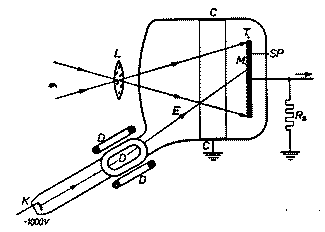
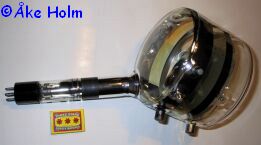 |
The Iconoscope was developed by
Vladimir Zworykin, and used in electronic TV
broadcasting from 1939 until it was replaced by more advanced tubes.Inside the Iconoscope,
the image is projected on a mosaic (M) consisting of
granules of photo-emissive material. Emission of photo-electrons from each
granule in proportion to the amount of light results in a
charge image being formed on the mosaic. Each granule, together with the
conductive plate behind the mosaic, forms a small capacitor, all of these
having a common plate. The capacitors are discharged in succession when
the mosaic is scanned by a high velocity electron beam (E) from the electron
gun, and the resulting changes in potential at the metal plate constitute
the picture signal.
The "sensitivity" is 75 000 lux.
The picture shows RCA 1850A. The price in 1948 was USD 540,- |
|
Image-Iconoscope |
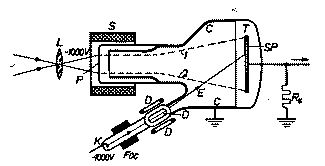 |
This has a kind of electron
multipier to improve the sensitivity which has been increased to 1000 lux. |
|
P.E.S-Photikon |
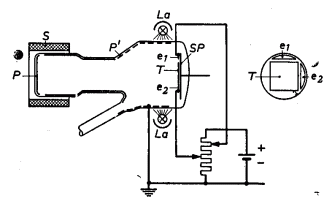 |
Here a bias light is
introduced to further improve the sensitivity to 300-500 lux |
|
Orthicon |
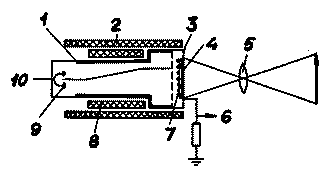 |
The electron beam has a
relatively low speed and magnetic focusing is needed to keep the beam
narrow. The anode is placed in the same end as the electron gun and the
return beam is modulated according to the light input.
Sensitivity 3000 lux |
|
Image
Orthicon |
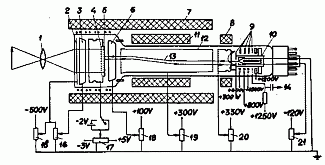
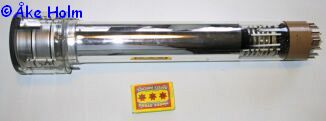
|
The Image Orthicon was a big
step forward. It includes a five stage electron multiplier. The picture
shows the 3" RCA 5820.
Sensitivity 200 lux
Dimensions: 75 mm diam, 385 mm length, weight 400 grams. |
|
Vidicon |
|
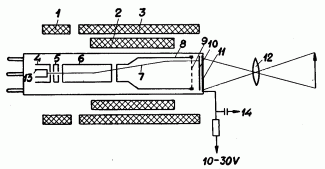
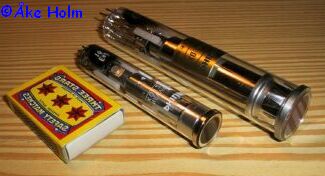
|
Sensitivity 500 luxPicture shows:
Philips XQ1270 3/4", diam 19 mm, length 100
mm, weight 23 g.
Philips XQ1030 1",
diam 27 mm, length 140 mm, weight 50 g.
|
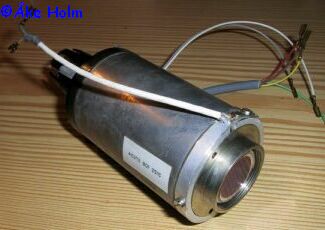 |
Vidicon
with magnetic deflection unit. |
 |
The Spectraplex
vidicon type 4445 was RCA's attempt to create a single tube color TV camera.
They made one camera model with this tube. Further history is unknown.
The size is : diam: 25 mm, length 140 mm.
Weight: 50 grams. |
|
Plumbicon |
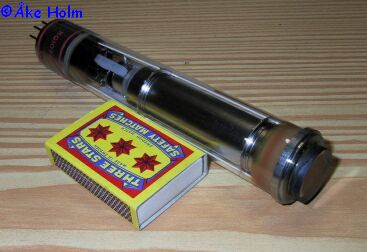 |
Philips
improvement of the vidicon. The picture shows XQ1074
which were available in three versions, R, G and B for colour TV camera. |
|
And
for comparison
only: |
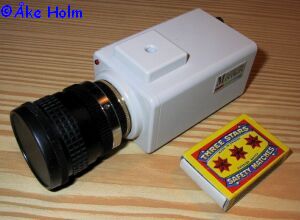 |
A
small solid state color TV camera "Mintron" with C-mount for
lens.
Dimensions: 110 x 55 x 50 mm. Weight: 360 grams excl. lens, 470 grams incl. F1,4/16mm lens.
Power needed: 12 VDC,
100mA. Sensitivity: 4 lux.
Output signal: 1,0 Vpp composite video. Can be externally synchronized. |
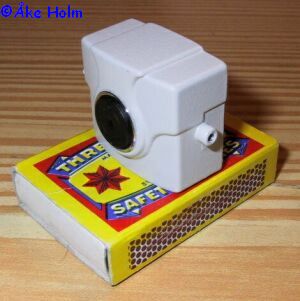 |
An ultra miniature solid state pin hole color TV camera with 1/4" CCD
sensor. Built in 4,3 mm lens / f2,8.
Dimensions: 19 x 33 x 29 mm. Weight: 50 grams.
Power needed: 5 VDC
Sensitivity: 2 lux, 330 lines resolution, 290 000 pixels.
B/W version of camera has 0,1 lux sensitivity !!!
Output signal: 1,0 Vpp composite video.
Made by COP Security Taiwan.
(Yes, it is the same matchbox) |
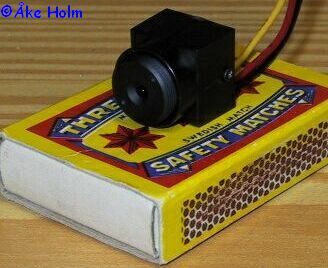 |
A micro sized monochrome camera
for surveillance use, type CAMZWCMM. It measures 15 x 15 x 17 mm. Weight: 5
grams, Power needed 12 VDC. Sensitivity 0,5 lux. Made somewhere in Taiwan.
(Still the same matchbox) |
|
 |



![]()
![]()





